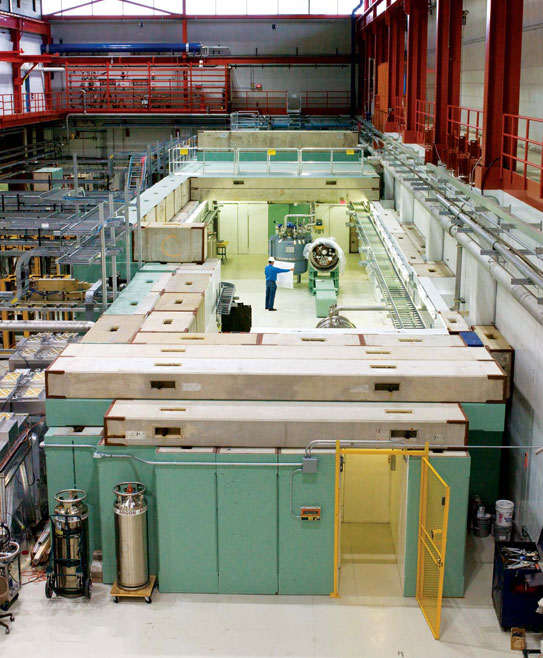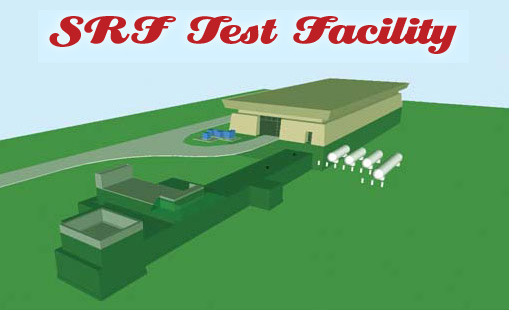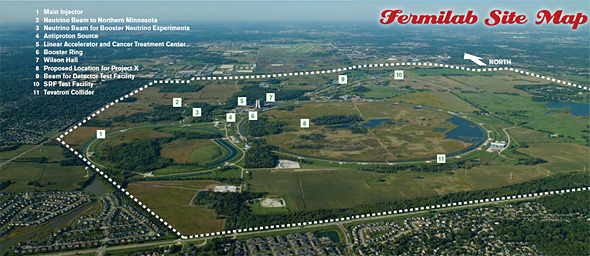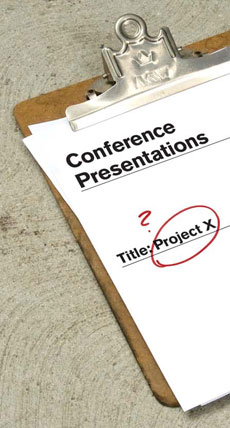Superconducting technology, Chicago style
Fermilab is cooking up a hot technology—and the serving is ultracold. The laboratory is stepping up efforts to develop and test superconducting radio-frequency cavities, a key technology for the next generation of particle accelerators and the future of particle physics.
By Kathryn Grim
 |
|
| Illustration: Sandbox Studio | |
| (Click image for larger view) | |
For decades, Fermi National Accelerator Laboratory has been known for innovations in the design and construction of particle accelerators.
Its scientists and engineers developed the materials needed to build the superconducting magnets that steer protons and antiprotons in Fermilabs particle collider, the Tevatron. The same technology now beats in the heart of the Large Hadron Collider at the European laboratory CERN.
Now the Chicago-area lab is learning the ropes of a new accelerator technology considered crucial to the future of particle physics: superconducting radio-frequency cavities.
SRF technology is a highly efficient way to accelerate beams of particles. It starts with shiny, curvy, virtually perfect cells made of niobium, a superconducting metal, and strung together like hollow pearls. Several strings, or cavities, nestle in a vessel called a cryomodule, which bathes them in liquid helium and keeps them at the ultracold temperature that is key to their operation and efficiency.
Fermilab is not the first laboratory to use SRF. In the United States, Thomas Jefferson National Accelerator Facility and Cornell University have greatly advanced the technology. The German laboratory Deutsches Elektronen- Synchrotron, or DESY, has been developing SRF technology for more than a decade and uses it in its new X-ray laser. Other European and Asian laboratories have also gained expertise in this area and have begun the process of industrializing the production of SRF cryomodules.
Now, with more than $55 million from the American Recovery and Reinvestment Act—better known as the economic stimulus package—Fermilab is poised to expand its SRF test facility and take its place among these leaders, while at the same time helping boost American manufacturing capabilities.
With help from DESY and Italys Istituto Nazionale di Fisica Nucleare (INFN), Fermilab engineers have already assembled one SRF cryomodule and are working on a second one. Working with several companies and with the help of other national labs, they are preparing to build a fully functioning prototype SRF accelerator.
"We struggled for the last year and a half due to budget problems," says Jerry Leibfritz, project leader of Fermilabs SRF test facility. "Now everythings ramping back up. The stimulus money is going to get us back on track and give us the R&D infrastructure to become a leader in SRF technology."
A step toward Project X
Fermilab scientists hope that work at the test facility will culminate in the construction of new particle accelerators in the United States. One has a curious name: Project X, a new proton accelerator proposed for the Fermilab site, where it would fit nicely in the center of the four-mile Tevatron collider ring.
Project X would replace an aging linear accelerator and booster ring, which generate protons for the Fermilab collider and neutrino programs, with a new accelerator complex that could provide three times as many protons in beams with up to two megawatts of power, a world record. Physicists would use the new proton source to create the most intense beams of subatomic particles—including neutrinos, kaons, and muons—ever made in the laboratory. Whats more, the new machine would generate beams for several experiments at once, each at the right energy and with the right type of particle.
Physicists could also use Project X as the front end of a new kind of energy-frontier collider, one that makes beams of muons collide.
"We want to run multiple projects simultaneously," says Fermilabs Ron Ray, project manager for an experiment called Mu2e. "Project X can give us that kind of flexibility."
Building Project X would provide Fermilab with a new, top-notch particle physics research program following the planned closing of the Tevatron, which will soon be eclipsed as the most powerful collider in the world by the Large Hadron Collider in Europe. It will also provide several options for future upgrades to the Fermilab accelerator complex.
Once approved, Project X could be built over a five-year period starting in 2013 or 2014; "It all depends on funding," says Steve Holmes, Fermilab associate director for accelerators.
Scientists at Fermilab are considering various configurations for this upgrade, but "its almost irrelevant what the exact design will be," says Sergei Nagaitsev, project manager of the labs SRF test facility. "SRF is going to be the bread and butter for future accelerators."
A necklace with kick
An SRF cavity resembles a pearl necklace pulled into a straight line. Running through the string of pearls, or cells, is an electric field that oscillates between positive and negative at a rate of 1.3 billion cycles per second. Each cycle, or wave, swells to its peak and sinks to its valley within the space of a single cell; it is as if each cell rapidly switches between a positive and negative charge.
The cycles are timed to kick charged particles riding the wave from cell to cell. Each time a positively charged proton enters a cell, that cells charge changes to negative, which attracts the proton. As the proton leaves the cell, the cells charge changes to positive and pushes the proton forward. Traversing the next cell, the proton is propelled in the same fashion. This process continues until the particle has shot all the way through the accelerator.
The design of the prototype accelerator at Fermilabs SRF test facility is similar to the one proposed for the International Linear Collider, a proposed electron-positron collider. Each cavity will be a necklace of nine cells, and eight of these cavities will fit into a cryomodule. When complete, Fermilabs prototype accelerator will have six cryomodules.
Superconducting radio-frequency cavities are difficult to make because they must be almost flawless. Their production and assembly must take place in clean rooms. The slightest irregularity or even a speck of dust would throw a cavity off kilter.
"The complexity is exaggerated by the fact that after you assemble everything, cool it, and put it into operation, you can no longer access the individual components," Nagaitsev says. "Its as if you assemble the cryomodule and then send it into space."
It now takes several months to produce a single ILC-type cryomodule; at that rate, even with Europe, Asia, and North America working together, it would take hundreds of years to craft the 1600 cryomodules needed for the ILC.
Saving energy with SRF
Cooling the SRF cavities to ultra-low temperatures in cryomodules has a huge benefit: It saves energy. When chilled to almost absolute zero, SRF cavities have no electrical resistance and conduct electrical currents without loss.
Working with several companies and Department of Energy national laboratories, Fermilab is trying to find ways to make the production of cavities and cryomodules faster and cheaper, so the process can be industrialized. Although the laboratory has never used SRF technology in its accelerators, Fermilab engineers do have lots of experience working with the Tevatrons superconducting magnets, which also operate at cryogenic temperatures.
The cryomodules for Project X would not necessarily be built to the same design as the ones for the ILC. Even so, building them brings Fermilab and American companies closer to having the capability needed to build future accelerators, says Fermilab scientist Bob Tschirhart.
"You can learn a lot about how to build a Ford by building a Chevy," he says. "The designs share a lot of the same components."
Neutrinos and more
The first use for Project X would be to produce the worlds highest-intensity neutrino beam, a project that lab Director Pier Oddone would like to start as soon as possible.
"Ideally, we dont let grass grow under our feet," Oddone says. "Right now if we make a move, we have the opportunity to attract many collaborators."
Neutrinos are some of the most abundant and least understood particles in the universe. They very rarely interact with matter, so they can pass through the entire Earth as if it were empty space. Yet scientists think that neutrinos played a critical role in the early universe.
"Its our role to understand the basics of matters interactions, and neutrinos are one area where we dont have that understanding yet," says Fermilab physicist Bob Zwaska. "Neutrinos are a basic unit of the universe. Theyre everywhere. And they fit into larger puzzles too—cosmology, matter-antimatter asymmetry and the dynamics of supernovae."
Fermilab has conducted neutrino experiments since the 1970s. In 2005, the laboratory launched the MINOS experiment, which studies a beam of neutrinos that travels from Fermilab to a detector in an underground mine 450 miles away in Minnesota. Two months ago, Fermilab broke ground for another long-distance neutrino experiment: NOνA. More neutrino experiments are in the planning stages.
NOνA and future neutrino experiments would benefit from better, higher-intensity neutrino beams. Project X could provide those beams.
 |
|
| Fermilab has begun to install the first components of a prototype accelerator in its SRF test facility. Scientists expect that superconducting radio-frequency cavities will be the technology of choice for the next generation of particle accelerators. Photo: Reidar Hahn, Fermilab | |
Meet the muons
But neutrinos are not the only particles that may hold the key to expanding our understanding of the world around us. Scientists are also interested in their electrically charged cousins, including the muon. The study of muons could give scientists insights into physics beyond the Standard Model. Theoretical models such as supersymmetry predict quantum effects in muons and other leptons that could be cleanly detected and unambiguously interpreted as new physics.
The proposed first phase of Fermilabs charged-lepton research program, the Mu2e experiment, would take place before breaking ground for Project X. But if Fermilab goes on to build Project X, physicists could upgrade the Mu2e experiment and measure muon interactions and decays more thoroughly, with a much more powerful beam.
"Project X would allow us to extend the investment we made in Mu2e," Ray says.
Farther into the future, the SRF technology could lead to the International Linear Collider. Scientists in Europe, Asia, and North America already are working on the design of such a machine.
And decades from now, Project X could also feed into a new kind of high-energy collider, one that brings beams of muons into collision. Muon collisions are easier to study than collisions between protons, the particles that will speed around the Large Hadron Collider; and a muon collider could reach much higher energies than an electron-positron collider.
"Superconducting radio-frequency technology will be a big part of high-energy physics in the future," Ray says. "Work at our test facility will give us the real experience of building an accelerator of that type."
Expanding the test facility
Fermilab will use Recovery Act funds to double the length of its existing SRF test facility, which is now about 70 meters long. This will extend the building enough to encompass a complete prototype accelerator with additional test beam lines.
Recovery Act funding will also go toward building the cryogenic plant that Fermilab needs to cool SRF cryomodules to minus 271 degrees Celsius, the operating temperature for SRF technology. The plant will have the capacity to cool future cryogenic projects as well, turning the Fermilab complex into one of the best SRF R&D centers in the world.
Engineers from DESY and INFN supplied the parts and assistance necessary to assemble the first SRF cryomodule at Fermilab. Fermilab plans to finish a second cryomodule, this one with some American-made parts, in early 2010. The assembly of these cryomodules represents the crucial step of going from a set of blueprints to building an accelerator.
European manufacturers of SRF technology have an advantage over manufacturers in the United States: They have been working on this technology for more than 20 years. Whereas about 80 percent of the cavities they build meet the standards Project X would require, only about 50 percent of American-made cavities now make the cut.
Over the next few years, engineers at Fermilab plan to catch up with their European counterparts and further spur manufacturing capabilities in the United States. So far, three American companies are building SRF cavities.
Whether or not Project X comes to fruition, Fermilab will benefit greatly from its new SRF test facility, Oddone says: "Our SRF test facility opens broad horizons. It will move us forward with our Project X plans, and prepare us to build the next-generation particle collider."
 |
|
| Fermilab plans to double the length of its existing SRF test facility to make room for a longer prototype accelerator with additional test beam lines. Image courtesy of Fermilab. | |
The project with the mysterious name
The name of a proposed project to upgrade Fermilabs accelerator complex sounds like something out of science fiction. A steering committee found it difficult to name a project with the potential to transform the abilities of the Fermilab accelerator complex in various ways, so they started using "Project X" as a placeholder until they came up with something else. "We werent worried about the name," says Fermilab Deputy Director Young-Kee Kim, who chaired the committee. "We were worried about the content of our discussion." The name sometimes leads to confusion. Fermilab physicist Sergei Nagaitsev recently included the name "Project X" in the title of a presentation he was to give at a conference in Russia. " I waited and waited, and they didnt get back to me," he says. When he finally contacted the organizers of the conference, they told him that they thought his registration was incomplete. "Youve left an X in your title," they said. Kim is still accepting suggestions for a new name. But by now, it may be too late to change it. "At this point its a pretty recognized name in the community," says Steve Holmes, Fermilab associate director for accelerators. "Personally, I like it." "Project X" found firmer footing when the media fell in love with the moniker, which is also the title of a 1987 film about a military animal-testing conspiracy starring young actors Matthew Broderick and Helen Hunt, along with a chimpanzee. "The name took on a life of its own and stuck," says Ron Ray, project manager for Fermilab's Mu2e experiment. |
Click here to download the pdf version of this article.








